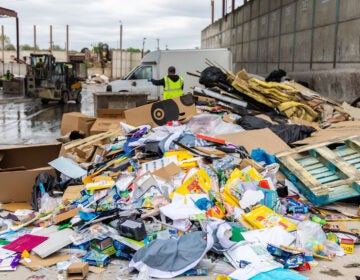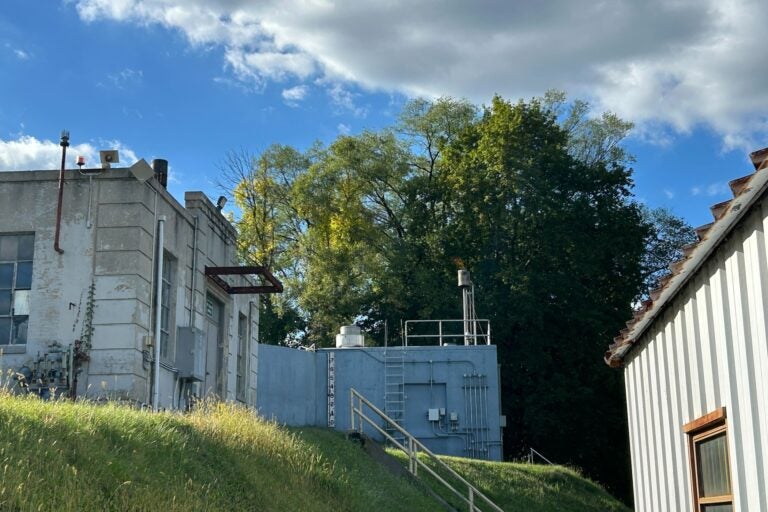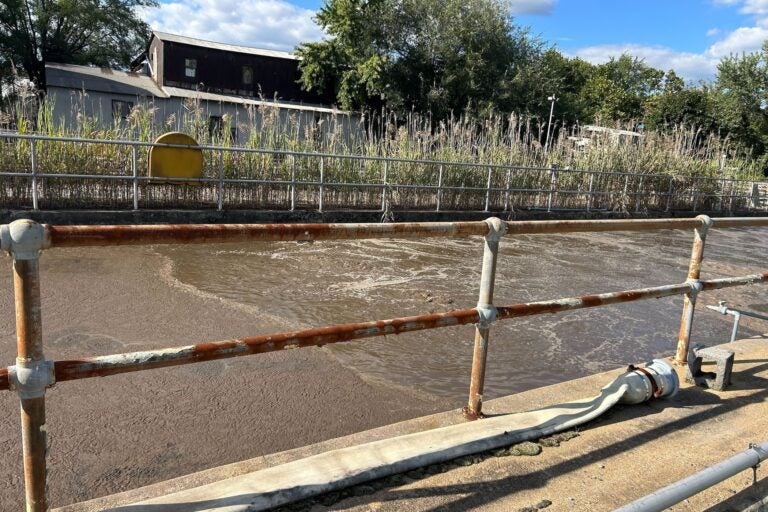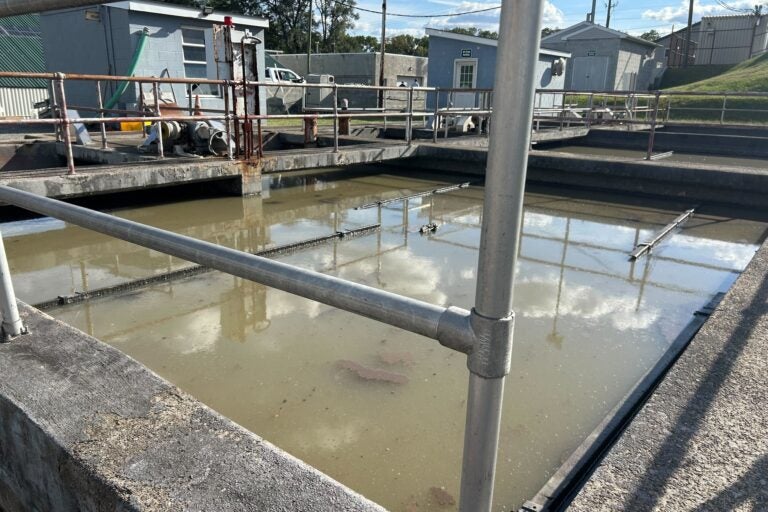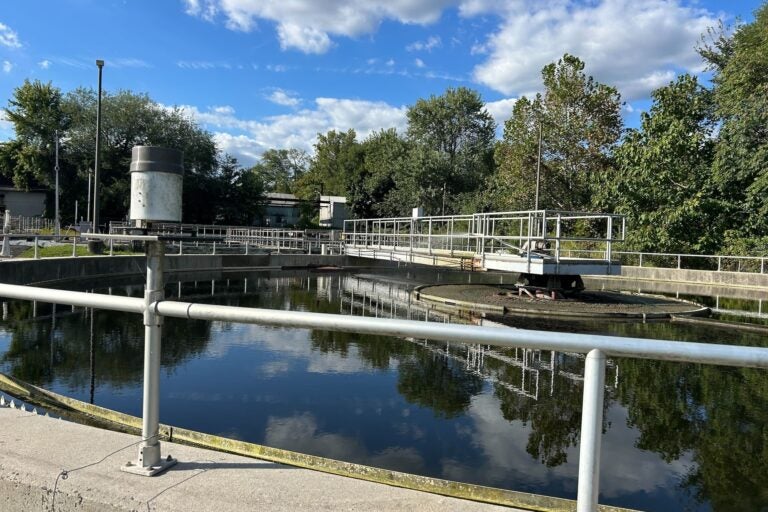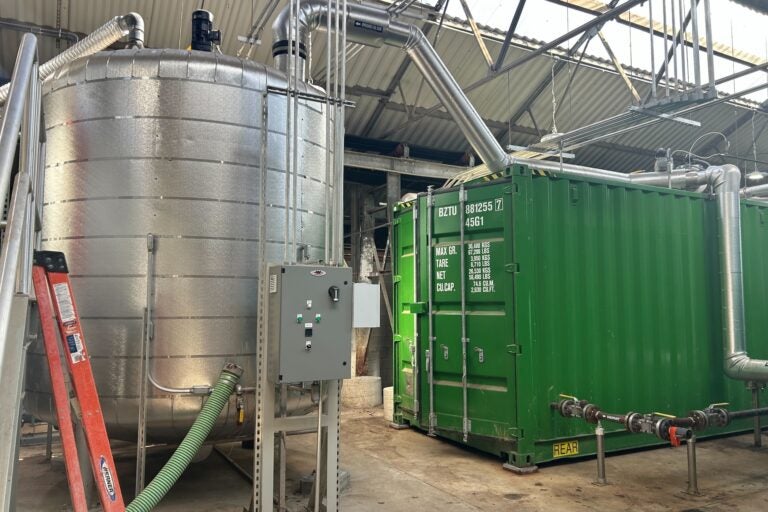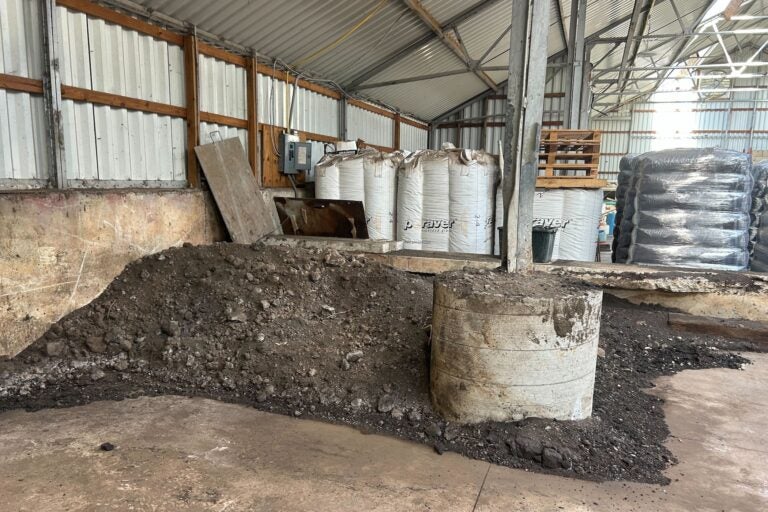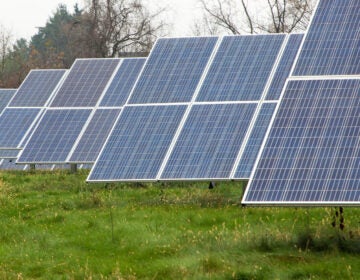Can Phoenixville’s sewage become ‘guilt-free coal’?
The municipality has invested millions to pressure cook sewage sludge, in hopes of cutting its climate pollution.
Listen 1:12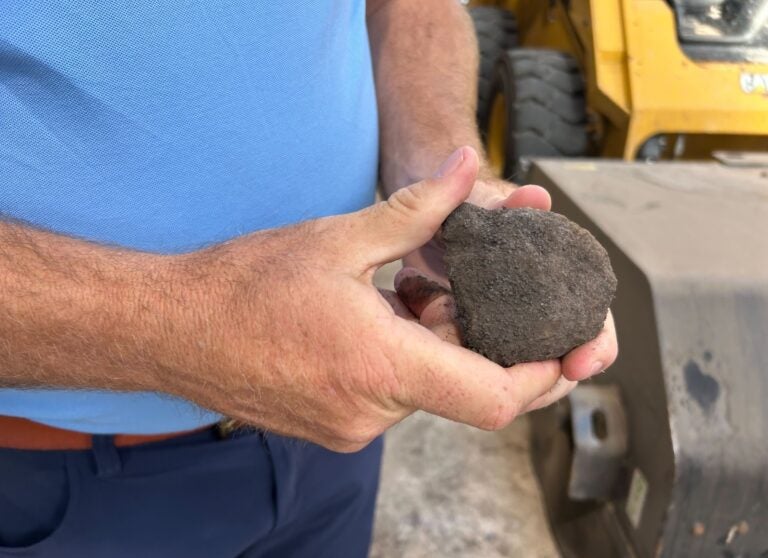
A chunk of biocoal made from Phoenixville’s sewage. (Sophia Schmidt/WHYY)
This story is part of the WHYY News Climate Desk, bringing you news and solutions for our changing region.
From the Poconos to the Jersey Shore to the mouth of the Delaware Bay, what do you want to know about climate change? What would you like us to cover? Get in touch.
Inside a new building at Phoenixville’s sewage treatment plant, shiny, silver pipes wind between a heating apparatus, through green shipping containers and a giant hydraulic press. Nearby, against a wall sits a pile of a dark, brown substance that looks like dirt.
But it’s something much more valuable than dirt. It’s “pretty much” coal, said Dan Spracklin, the founder of a company called SoMax. But instead of being mined from deep underground, it’s made from sewage sludge, or as Spracklin puts it, “today’s carbon.”
“This was food that you ate,” Spracklin said, picking up a lump the size of a potato during a recent tour of the facility. “You went to the bathroom. We processed it.”
“This is like guilt-free coal,” he added.
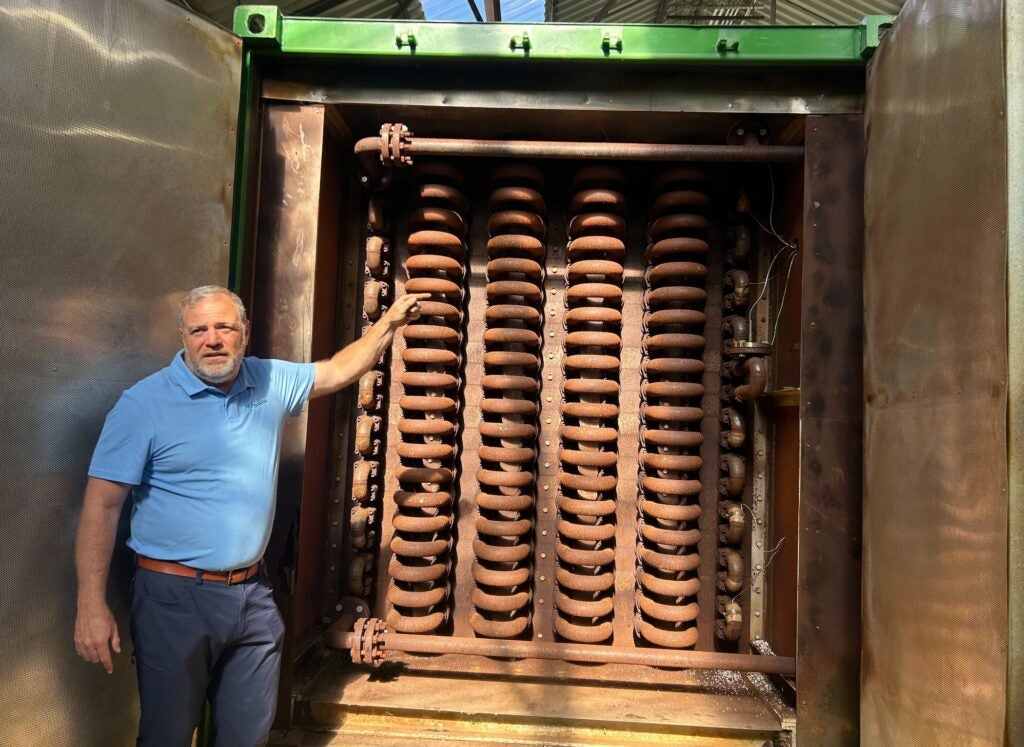
It’s “guilt-free” because when this coal-like substance is burned, it releases carbon dioxide — but only carbon that just months ago was pulled from the atmosphere by plants or consumed by animals to create the food that Phoenixville residents ate, Spracklin said. Mined coal, on the other hand, releases carbon that had been sequestered underground for millions of years.
To turn Phoenixville’s sewage sludge into this energy-rich substance known as hydrochar or biocoal, Spracklin’s company uses a process called hydrothermal carbonization.
It uses pressure and heat within the range of a home oven to speed up the natural fossil fuel formation process by millions of years.
The new facility in Phoenixville, called PXVNEO, is a collaboration between the borough and Spracklin’s company. It claims to be the first of its kind to break ground in North America, though a similar facility was also recently built in Mexico City. The facility could start processing Phoenixville’s sewage as early as this spring.
The borough first announced the project in 2022, with the goal of eventually creating a circular system at the sewage treatment plant, where the town’s waste generates more than enough power to run the plant. Officials hoped to start operating the facility in 2024.
But after a test run in 2023, neighbors noticed a new odor wafting from the wastewater treatment plant — one that smelled like “burnt coffee” or “burnt cabbage,” said E. Jean Krack, Phoenixville’s borough manager.
“There’s a little bit of [an] aroma here,” Krack said of the new hydrothermal carbonization plant. “We have to control that. We don’t want to offend our neighbors.”
So the borough ordered a “supercharged” air filter to control the odor, which should arrive by the end of this year, Krack said.
Next, Phoenixville needs to obtain an operating permit from state environmental regulators, which Krack hopes to receive early next year.
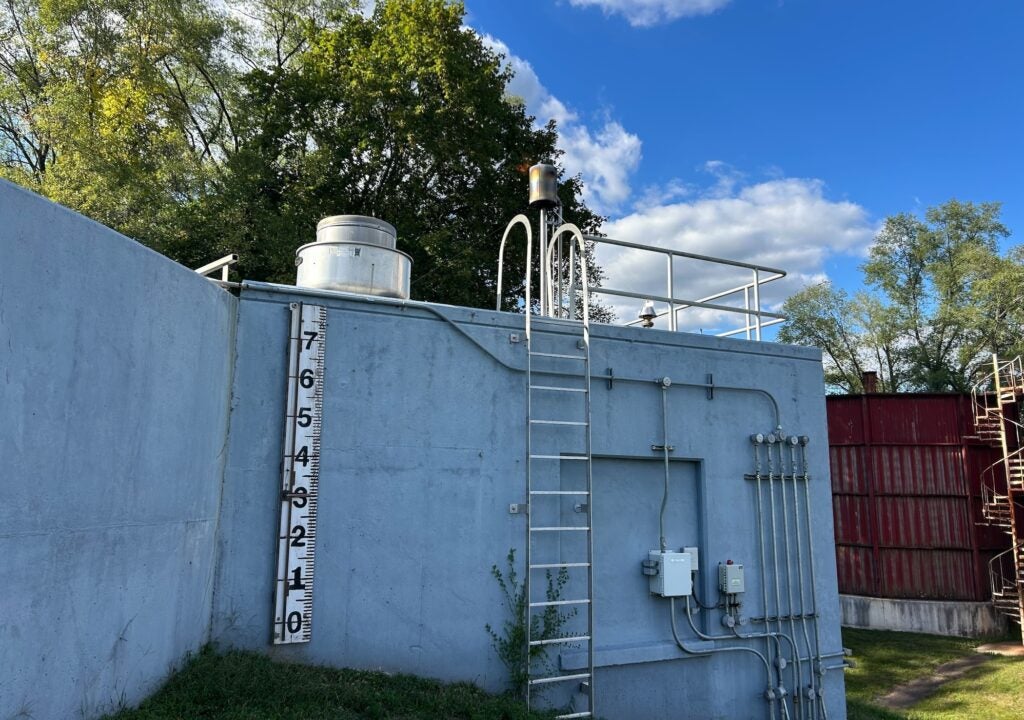
Why Phoenixville sees ‘guilt-free coal’ as a climate solution
SoMax and Phoenixville officials hope the hydrothermal carbonization facility will decrease the borough’s planet-warming emissions and advance its climate goals.
While “biocoal” may sound dirty, boosters argue it traps much of the carbon that would otherwise be released to the atmosphere from sewage sludge. When it’s burned for energy, it can replace coal that would otherwise be mined from underground — decreasing greenhouse gas emissions overall.
“If we did nothing to the biosolids, it would already emit that CO2,” Spracklin said. “Here we can gasify it or burn it for energy, and then burning that will release that same amount of CO2, but it’s not additive to the atmosphere.”
After it’s made at a facility like Phoenixville’s, there are three paths biocoal can take. It can be incorporated into building materials like bricks or cement, where its carbon stays sequestered for as long as the material survives. It can be burned for energy, and its carbon will be released into the atmosphere. Or it can be buried in a landfill, where microbes will release some of the carbon and the rest will remain trapped, said Juliana Vasco-Correa, a professor of agricultural and biological engineering at Penn State University.
If the biocoal made from Phoenixville’s sewage sludge were sold for use in bricks or concrete, Spracklin estimates it could sequester roughly 375 tons of carbon dioxide annually, the equivalent of taking around 80 gas-powered cars off the road each year.
But because Phoenixville’s plant would be the first in the U.S., there’s not yet a market for biocoal in building materials, and the borough would not be able to find buyers, Krack said.
The wastewater treatment plant is Phoenixville’s biggest municipal energy user. Borough officials want to see it produce all of its own energy through biocoal — plus extra, to power other municipal buildings.
Krack envisions biocoal-powered boilers at each of the borough’s municipal buildings. But he says the right-sized boilers aren’t currently available.
“We’re a long ways away from that,” Krack said.
“It will happen,” he added. “I just don’t know when.”
So in the short-term, Phoenixville plans to use the third path for its finished biocoal: bury it in a landfill.
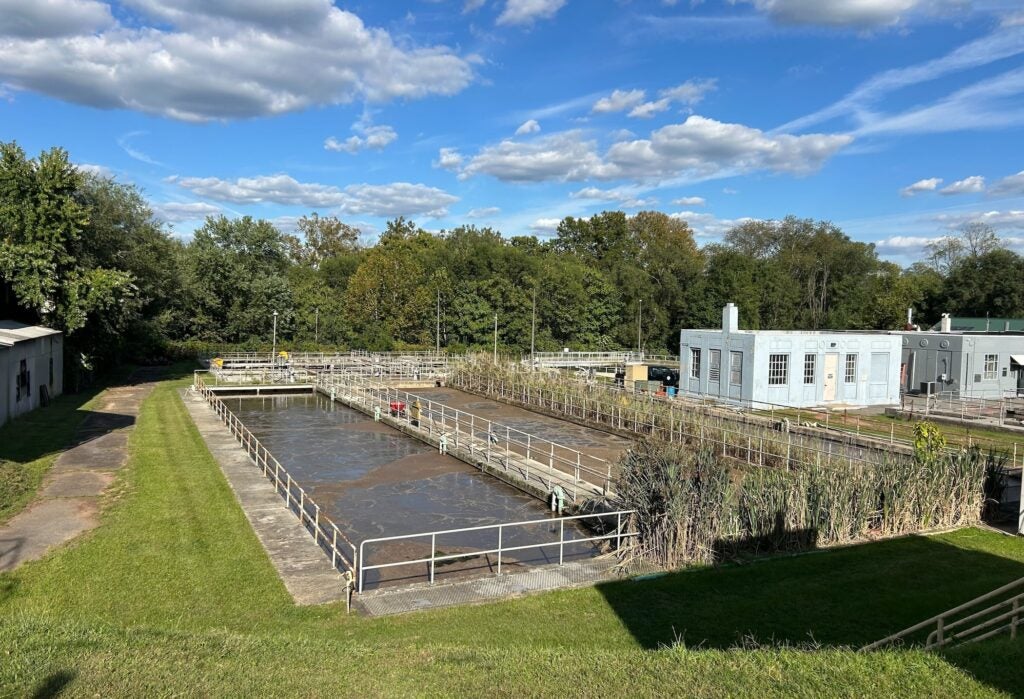
How does producing biocoal compare to Phoenixville’s current process?
When evaluating whether a new process reduces climate pollution, it’s important to consider its entire lifecycle and compare it to what would otherwise be done, said Sintana Vergara, an environmental engineer who studies waste management and climate at Swarthmore College.
Currently, the borough’s sewage sludge is broken down by bacteria in a process called anaerobic digestion, which produces methane, a powerful greenhouse gas. Much like biocoal, this methane can be captured and burned for energy — but the borough does not do this. Instead, Phoenixville burns off the methane using a flare, which emits carbon dioxide, a less powerful greenhouse gas, to the atmosphere. Krack said the amount of gas the process releases does not warrant the “significant costs” it would take to capture the gas for energy.
Both today’s process and the new biocoal-producing process require inputs of energy — natural gas to heat the sewage sludge, electricity from the grid to run the plants and fuel to transport the end products to landfills or agricultural land where it can be applied. All of these sources of energy contribute to climate change. Both processes also release greenhouse gases at the sewage treatment plant and at the end products’ final destinations.
Spracklin said hydrothermal carbonization takes less energy than the borough’s current process and has fewer emissions overall. But he said he has not done a full lifecycle assessment comparing the two processes, assuming the biocoal ends up in a landfill.
Vasco-Correa said creating biocoal and sending it to a landfill has the potential to store more carbon than Phoenixville’s current process. But in order to know for sure, an independent party would need to quantify the emissions associated with each step in the supply chains of both processes and test the composition of the finished biocoal to determine how much gas it would release in a landfill, she said.
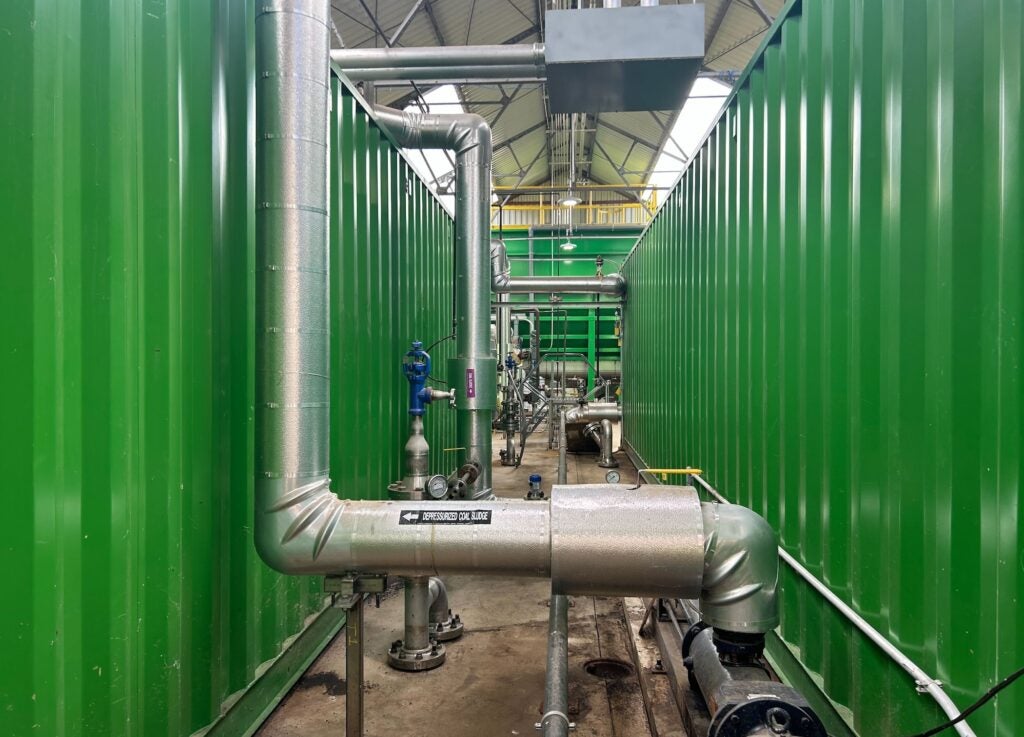
How much will the project cost?
The PXVNEO facility cost the borough roughly $6 million to build, which included about $1 million worth of grants from Chester County and the state, Krack said. The rest came from reserves funded by borough residents’ and businesses’ wastewater bills.
The borough expects the yearly cost of running the hydrothermal carbonization system and transporting the end product to landfills will be less than its current costs using anaerobic digestion, but Krack said the borough won’t know until the facility is up and running.
Phoenixville’s wastewater sludge will only use up about one-quarter of the PXVNEO facility’s capacity, so the facility will likely operate in batches, rather than continuously throughout the year. The facility could eventually process food waste as well, or generate revenue for the borough by accepting sewage sludge from surrounding municipalities, Spracklin said.

Get daily updates from WHYY News!
WHYY is your source for fact-based, in-depth journalism and information. As a nonprofit organization, we rely on financial support from readers like you. Please give today.



